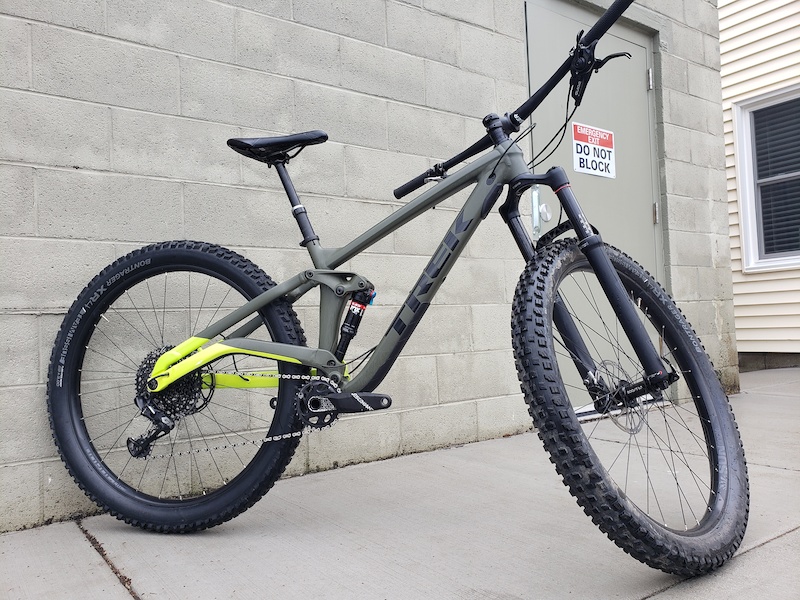


- Trek stache 7 2017 hardtail mountain bike green plus#
- Trek stache 7 2017 hardtail mountain bike green series#
BUT, a good low pressure gauge is key, 1/2lb is a noticeable difference in how the bike rides.
Trek stache 7 2017 hardtail mountain bike green plus#
The plus tires take the edge of the aluminum frame also. I can't count the number of times I've had to ride the brakes coasting to keep from hitting my buddies in front of me on regular 29er single speeds. But that same thing helps you maintain momentum like crazy. The big tires and wheels do have more of a gyro effect, so you may work a little harder on quick side to side transitions. It also means I've cleaned climbs I haven't made on any other SS, especially loose over hardpack or leaf / pine straw littered trails. The amount of traction on tap means I can carry more speed through corners, and other places I'd be slower on a standard tire. Single speeding to me is a lot like 125cc motocross, it's all about conservation of momentum, and anything you can do to help that will generally yield positive results. That being said, I am a bigger guy at 190lbs sans gear, so that may play into it somewhat. Well, for me at least, I greatly prefer it to standard sized tires. That's a very valid point Andrew, you can always take some off, but can never put some back on. So I dont think this will replace your latest and greatest super-enduro sled but otherwise i think the last sentence in the article is likely a fair summary. and the tires are $150/ea at retail to replace. local terrain doesnt have rocks but I would be leery how long the tires would last riding sharp rocky terrain at speed (they have been surprisingly durable on the dirt, roots and gravel I ride on though). the big tires offer goofy fun traction but they are slow to transition into and between corners. It is very sensitive to tire pressure and if a bit low any aggressive cornering is unnerving. but after that I suspect you're better off on a smaller tired/wheeled bike. I think its an excellent all round bike for beginner - intermediate rider or up to 2/3 - 3/4 speed for an expert. rolling resistance seems not much different from my other bikes. once snow is packed down a bit and if not icy, I think its better than a fat bike. you can pad thru wet soft trails instead of digging trenches. the tires worked really well in the type of mud we have (i.e., I can keep pedaling vs hardly being able to walk on my 26" bikes with minions). my regular rides are still 26 (HT and 160 FS) and I got a Stache 5 last fall.įor where I live, it is a fantastic wet weather, snow and winter bike. I suppose an ankle pad would be an option for a long-term fix.Looking forward to your ride review, a comparison of the 29+ vs the more common 27+ would be great as I have been curious about that. I spaced out the bottom bracket and pedal a bit, which helped, but it didn’t fully solve the problem. This is because it’s right at the level of my back foot in descending position. The only challenge for me, personally, is that I tended to ding my right ankle on the raised chainstay when giving it too much English or getting bounced around on rocky sections. Plus, it doesn’t fit into any of today’s bike category boxes it’s a one-of-a-kind design and riding experience. It’s reminiscent of those early ‘90s front-suspension hardtails - like my trusty Yeti ARC with a RockShox Mag 21 - but the exaggerated tires and modern technology make it feel right at home on today’s black-diamond flow trails. It’s fun because it harks back to why we started riding in the first place.namely, for fun. There’s no question: the Trek Stache is a blast to ride. When all was assembled, it tipped the scale at 26.5 pounds, which is right in line with a high-end trail bike. Other component choices include the Selle SMP 209 saddle and Chris King NoThreadset headset. Many ways to dial and adjust these brakes on the fly Reed Apparently, this is something you have to get used to with a plus bike in order to get the most out of it. It should be noted that I bottommed the rear tire on the rim on pretty much every ride - often making a loud ping! noise - but never flatted or compromised the rim in any way. Altogether, the set weighs about 1,700 grams, and each tire weighs about 900 grams.
Trek stache 7 2017 hardtail mountain bike green series#
The M6 series is designed for trail use, and with an internal width of 40mm, the 640s support tires ranging from 2.8 to 3.2 inches. I sent the XTR hubs to ENVE to be built with its M640 hoops. The wheel choice, then, was pretty clear. It’s a hardtail that you punish like a full-suspension bike for the pure fun of it (with the added benefit of efficient climbing out of the saddle). This isn’t an XC hardtail, nor is it a bike for Strava PRs. One of the themes of this Stache build is that everything needs to be burly.


 0 kommentar(er)
0 kommentar(er)
